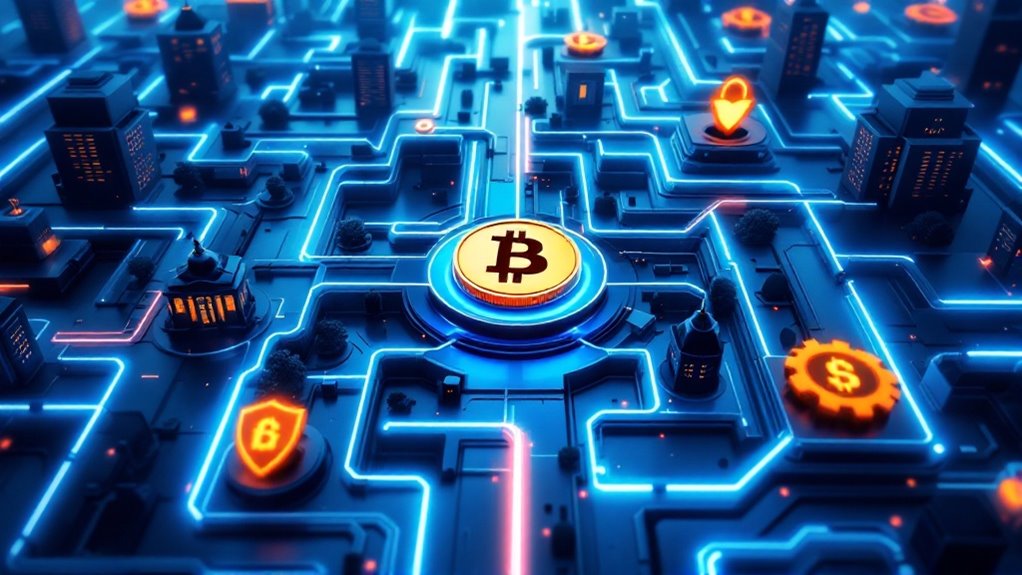NFT storage and security demand careful consideration in today's digital landscape. Hardware wallets provide vault-like protection for valuable digital assets, while software solutions offer convenience with inherent risks. Like precious jewels in a safe, NFTs require robust security measures against phishing, smart contract vulnerabilities, and marketplace hacks. Content-addressable storage systems guarantee lasting accessibility, while legal frameworks protect creators and collectors. The journey through NFT protection reveals layers of essential safeguards to explore.

As the digital art world continues to evolve at a dizzying pace, the challenge of safely storing and securing Non-Fungible Tokens (NFTs) has become increasingly essential for collectors and creators alike.
Like precious gems locked away in a vault, NFTs require robust protection through various storage options, each with its own set of tradeoffs. Hardware wallets offer the digital equivalent of a bank vault, keeping assets safely offline, while software wallets provide the convenience of a designer handbag – stylish but potentially vulnerable. Using multisignature protection adds an extra layer of security by requiring multiple keys to authorize any transaction. Experts strongly recommend using hardware wallets for storing valuable NFT investments.
The NFT landscape sparkles with promise, but shadows of security threats lurk around every corner. Sophisticated phishing attacks slice through unprepared defenses like hot knives through butter, while smart contract vulnerabilities can leave digital treasures exposed to theft. Each NFT represents a unique digital asset that cannot be replicated or exchanged like traditional cryptocurrencies.
The ecosystem has witnessed its share of dramatic heists and heartbreaks, from marketplace hacks that sent shockwaves through the community to devastating rug pulls that vanished like smoke in the wind.
Modern NFT marketplaces have risen to these challenges with increasingly sophisticated security measures. They're like digital fortresses, equipped with KYC procedures that act as drawbridges and security audits that serve as vigilant guards.
The underlying smart contracts, meanwhile, operate like invisible clockwork, governing transactions with mathematical precision while carefully maintaining essential access controls.
The quest for data persistence presents its own unique challenges in the NFT space. Content-addressable storage systems like IPFS serve as digital libraries, ensuring that NFT metadata remains accessible long after the initial minting.
It's a delicate dance between on-chain and off-chain storage solutions, each playing its part in the grand performance of digital preservation.
Legal considerations cast long shadows over the NFT landscape, with regulatory requirements shaping how these digital assets are bought, sold, and traded.
Like sailors steering through stormy seas, marketplace operators must carefully chart their course through evolving securities regulations and intellectual property rights.
The future of NFT security lies in finding the perfect balance between innovation and protection, ensuring these digital treasures remain both accessible and secure for generations to come.
Frequently Asked Questions
Can NFTS Be Transferred Between Different Blockchain Networks?
Yes, NFTs can be transferred between different blockchain networks using methods like burn-and-mint, lock-and-mint, or lock-and-unlock mechanisms. Various bridging protocols and platforms facilitate these cross-chain NFT transfers securely.
What Happens to My NFTS if the Marketplace Platform Shuts Down?
NFTs remain secure on the blockchain even if marketplaces close. Owners retain access through alternative platforms or personal wallets. While platform-specific utilities may be lost, the underlying NFT ownership persists on-chain.
How Can I Recover Lost NFTS From a Compromised Wallet?
To recover lost NFTs from a compromised wallet, users should immediately transfer remaining assets, revoke permissions, and utilize specialized recovery tools like Flashbots or MEV techniques to bypass sweeper bots.
Are Physical Backups of NFT Ownership Records Recommended?
Physical backups of NFT ownership records are strongly recommended. They provide essential protection against digital failures, serve as legal proof of ownership, and offer a tamper-resistant offline record of digital assets.
Can NFTS Be Duplicated or Copied by Unauthorized Users?
Yes, NFTs can be duplicated through methods like right-click saving, screenshots, or unauthorized minting. However, while artwork can be copied, the blockchain-verified ownership and unique token ID cannot be replicated.









